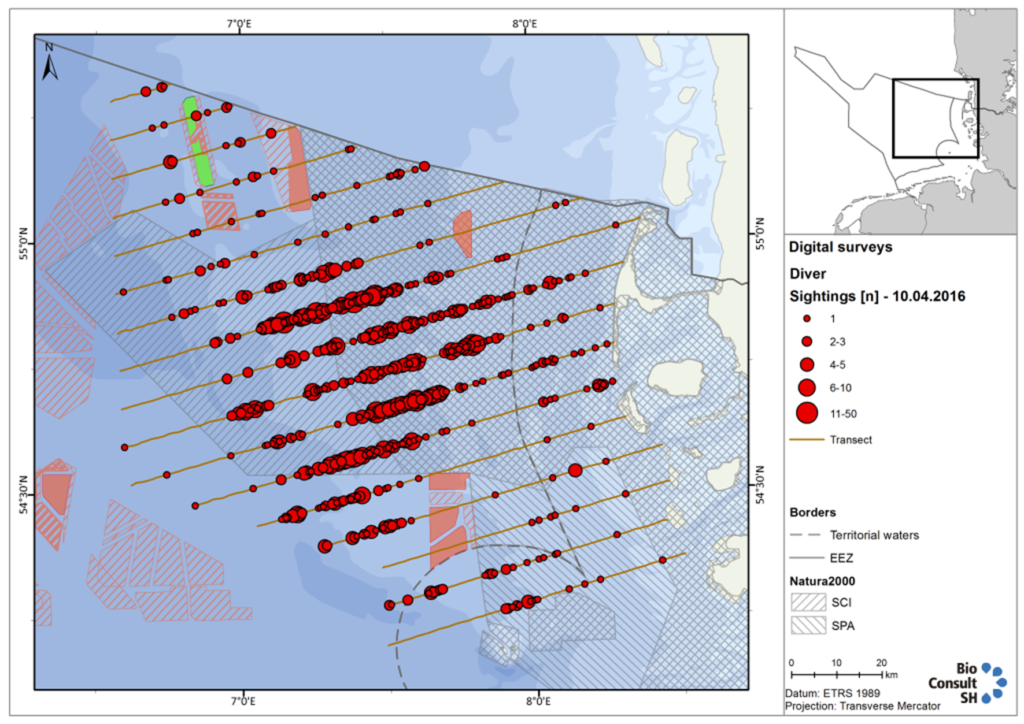The Project
In the DiverLog project, the impact of offshore wind farms on red-throated divers will be determined from the individual reaction to possible effects on the population. To do so, the movement patterns, as well as the most important activity of the red-throated divers, the search for food, will be investigated by analysing diving activity. These data will help to better understand the complex relationships and form the basis for individual-based modelling that can be used to estimate effects on the fitness and also to predict possible long-term population effects. The overall goal of the project is to provide a basis for both, the development of mitigation measures as well as for the spatial planning of offshore wind farms.
Therefore, red-throated divers will be captured and equipped with dataloggers in their resting area in the German North Sea over a period of three years. Using newly developed GPS loggers, the exact movement patterns can be recorded. With the help of integrated pressure sensors, the foraging behaviour of the red-throated divers can also be recorded.
The DiverLog project has the following objectives:
1. Habitat preferences: Movement patterns
Using high-resolution GPS data, movement patterns of red-throated divers in their wintering area will be investigated in relation to environmental parameters as well as offshore wind farms. This will include habitat modelling for both the North Sea and the Baltic Sea, which will help to identify suitable habitats for the species and determine avoidance distances to offshore wind farms. From previous studies, it is already known that factors, such as visibility, influence avoidance distances. This will be investigated in more detail with the improved dataset.
2. Diving behaviour and activity models
As red-throated divers are highly mobile, they regularly encounter offshore wind farms and other anthropogenic disturbances in different areas of the North and Baltic Sea, which may cause them to avoid certain areas, potentially resulting in energy losses. Information on diving or foraging behaviour can be used to determine daily energy consumption. Analysis of diving behaviour also allows a detailed description of seasonal activity budgets and energy consumption in different staging areas. Using a bioenergetic model, the DiverLog project will therefore compare activity budgets of red-throated divers from resting areas in the Baltic Sea with those from the North Sea. In addition, information on diving behaviour will be collected.
3. Habitat requirements: Differences between long and short distance migrants
In the DIVER project, nearby breeding areas in Scandinavia (Norway) and distant breeding areas in the Russian Arctic or western Greenland were identified as areas of origin1.
Birds from different breeding grounds often differ in their timing and physiology because they have different migration strategies. Birds migrating short distances usually accumulate only small reserves for migration, while birds migrating long distances often can only manage the migration distance with the help of large reserves and therefore rely more on areas of high quality (possibly including those with offshore wind farms) that provide sufficient energy for migration. The consideration of individuals of different origins and different migration strategies will therefore be used to analyse habitat requirements and the possible effects of anthropogenic influences in several staging areas.
4. Food spectrum
In the previous project DIVER, it was found that red-throated divers use a wide food spectrum of fish species in their wintering area. These studies on the food choices of red-throated divers will be continued and support the interpretation of habitat selection in their wintering areas2. The results will be compared with data obtained in the DIVER project to verify consistency.

5. Effects of offshore wind farms
Currently, it is unclear what effect the displacement of divers in the area of offshore wind farms has on the population. If red-throated divers are displaced by offshore wind farms from food-rich areas to areas with lower food quality, this may result in reduced food intake, potentially affecting the physiological condition and individual fitness of the birds, which in turn may impact the population. The effects of offshore wind farms and other anthropogenic disturbances on individual fitness and populations of red-throated divers will be investigated using an individual-based model (IBM). The goal is to predict long-term effects of offshore wind farms on red-throated divers.

- 1.Dorsch M, Burger C, Heinänen S, et al. DIVER – German tracking study of seabirds in areas of planned Offshore Wind Farms at the example of divers. Bio Consult SH. Published online 2020. doi:10.13140/RG.2.2.32688.10242
- 2.Kleinschmidt B, Burger C, Dorsch M, et al. The diet of red-throated divers (Gavia stellata) overwintering in the German Bight (North Sea) analysed using molecular diagnostics. Mar Biol. Published online May 16, 2019. doi:10.1007/s00227-019-3523-3